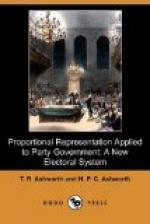The little republic of Switzerland has been the scene of nearly all subsequent improvement. In 1867 Professor Ernest Naville founded the Association Reformiste at Geneva to advocate the principle of proportional representation. In 1871 the Association adopted the Liste Libre system, invented by M. Borely, of Nimes, France, in which each elector was to place all the candidates of his party in order of preference. But as this allows the electors little direct influence on their own candidates and none outside of them, a combination of the cumulative vote and the Liste Libre was adopted in 1875. Each elector was to have as many votes as there were seats to be filled, but he could not only give them to any candidates on any list, but he could also give as many votes as he liked to any one candidate. Thus if there were ten seats to be filled the elector could give ten votes to one candidate, or one vote to each of ten candidates, or five votes to one candidate and divide the remaining five among others, and so on. The only condition necessary was that his votes added up to ten. The aggregate votes given to all the candidates of each party were then to be taken as the basis of proportional distribution among the parties and the highest on each list to the number decided were to be elected.
It was not till the year 1890 that this scheme was actually put into practice. The election of 1889 had resulted so unjustly to the Liberal party in the canton of Ticino that an insurrection broke out. This forced the hand of the Federal Government, which had to quell the disturbance, and proportional representation was recommended and adopted. Several other cantons followed suit, and it is expected that the whole of Switzerland will soon adopt the reform.
A modification of this plan has lately been adopted by the Swiss Association. In this later plan electors can give a single vote only to individual candidates, but if they do not use all their votes in this way they may cumulate the balance on any one party list by marking at the head of the list. Thus if the elector in a ten-seat electorate gives five votes to individual candidates, and places a mark at the head of one of the lists, the balance of five votes will count to that list. The aggregate votes given to individual candidates on any list, plus the votes placed at the head of the list, will form the basis of proportional distribution among the lists. This is the plan adopted by the American Proportional Representation League as most nearly suited to American habits, and recommended by Professor Commons in his book on “Proportional Representation.”




